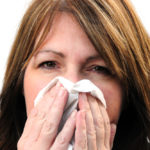By Bonnie Jenkins, Advanced Natural Wellness
You’re careful about what goes into your body – but what about the personal care products you slather on your body? Could they be jeopardizing your health?
Consider this: There are more than 5,000 cosmetic chemicals approved for use by the Food and Drug Administration, many of which have never been tested for safety. Although not all of these chemicals undermine your health, the National Institute of Occupational Safety and Health reports that 884 of them are toxic. And it’s amazing just how many of these hazardous chemicals can be found in the everyday products under your bathroom sink.
Behind The Bathroom Door
One of the greatest risks from using cosmetic and personal care products comes from the daily exposure to carcinogenic chemicals and cancer precursors. Among the most widely used carcinogens are the coal-tar colors, listed on labels as FD&C and D&C colors. Made from the liquid or semisolid tar found in bituminous coal, these colors may be contaminated with benzene, naphthalene, phenol and creosol. All have been found to cause cancer in animals and, although the FDA maintains that the risk to humans is minimal, the World Health Organization considers every coal-tar color a probable carcinogen.
Unfortunately, carcinogens aren’t the only hazards in cosmetics. In the 1970s, scientists discovered a new threat – one with far-reaching effects that impact the health of both adults and children. Endocrine disrupters are chemicals that interfere with the normal functioning of our hormones and may cause infertility, miscarriage, birth defects, reproductive and breast cancer, and thyroid, liver and kidney damage. The most common type of endocrine-disrupting chemicals in cosmetics are the phthalates, particularly dibutyl phthalate (DBP). Used as a plasticizer and solvent, this chemical lurks in a number of popular hair sprays, deodorants, perfumes and hand lotions – not to mention most nail polishes. Unlike some chemicals that wash out of your system rather quickly, DBP accumulates in your body’s fatty tissue where it can linger for years.
Although it can take decades for these carcinogens and endocrine disrupters to do their damage, a growing number of people are getting immediate reactions to the chemicals in everyday beauty products. In fact, in a single year, more than 200,000 visits to the emergency room are related to allergic reactions from cosmetic ingredients, particularly synthetic fragrances, colors and preservatives. Reactions can range from a case of mild contact dermatitis (inflamed, itchy skin) to full-blown anaphylactic shock.
Open your arteries, improve blood flow for a new health miracle...
Did you know your circulatory system has over 60,000 miles of arteries, veins and other blood vessels, if stretched end to end?
But as you age, your blood vessels undergo changes, which may cause them to stiffen, thicken and get clogged.
GOOD NEWS! Doctors have now identified a “Miracle Molecule” inside your arteries that helps OPEN your arteries and IMPROVE blood flow.
It’s what Dr. Valentin Fuster calls it, "One of the most important discoveries in the history of cardiovascular medicine."To you, that means...
- Healthy blood pressure
- Sharper mind and memory
- Skyrocketing energy and muscular strength
- Increased pleasure and passion in the bedroom
- Improved circulation to every cell and organ in your body
Go here to discover a new natural way to significantly boost the levels of this miracle molecule in YOUR body NOW!
Built to Last
With industrial chemicals making up the bulk of mass-produced cosmetic and personal-care products, you’d think they would last forever. Not so. Since mainstream cosmetics often sit on store shelves for months before you buy them, strong preservatives are added to keep bacteria at bay. Yet many of these preservatives, including DMDM hydantoin, quaternium-15 and diazolidinyl urea, release formaldehyde as they degrade.
German researchers recently identified at least one of these compounds, diazolidinyl urea, as a genotoxin and urged a reevaluation of their use. Other studies have found that another group of widely used preservatives, the parabens, mimic estrogen. One recent study by the Danish Center for Environmental Oestrogen Research found that two of these compounds, butyl- and propyl-paraben, have estrogenic properties comparable to bisphenol-A, a hormone-disrupting chemical used to make plastics.
Lax Laws and Persuasive Politics
So how do these potentially dangerous chemicals get into your bathroom? While most consumers believe that the FDA ensures the safety of the cosmetic and personal-care products we use every day, the truth is that the FDA doesn’t have the authority to require safety testing before a product appears on store shelves. What’s more, manufacturers aren’t required to report cosmetic-related injuries or submit safety data on the ingredients used in their products.
Thanks to weak, ineffective consumer regulation, the cosmetics industry is in the enviable position of policing itself – and it’s the Cosmetic, Toiletry and Fragrance Association’s (CTFA) job to keep it that way. The vast majority of cosmetic companies in the U.S. rely on the CTFA to protect their interests by compiling safety data from industry-funded scientists and by refuting independent research that shows that the ingredients used in hair dyes, deodorants, lipsticks and skin creams are potentially dangerous.
The World's Quickest Solution for Ending Prostate and Urinary Misery
This has recently been revealed to be one of the only real breakthroughs in prostate health.
The seeds of a strange fruit (sometimes called "Chinese Apples") hold powerful phytonutrients that are a revolution in prostate health.
In fact, UCLA and Veterans Administration research have now proved this to be true.
Not only that, but it may be the worlds quickest solution for ending prostate misery.
Simply stated, these phytonutrients represent a huge step beyond beta sitosterol, saw palmetto, and other phytosterols alone.
Simply click HERE if you want to have fast prostate relief...restful, uninterrupted sleep...no more constant "urges to go"...enhanced virility...and optimal prostate support for life.
Safer Selections
Of course, not all chemicals used in personal care products are dangerous. The trick is to know which ones to avoid. Along with the compounds I’ve mentioned, it’s good to avoid petroleum-derived ingredients like mineral oil and petrolatum. Petrochemicals coat the surface of your skin and prevent respiration. Opt instead for plant oils that penetrate the skin with their emollient properties. Good oils to look for include almond, apricot kernel, hemp, jojoba, sesame, and sunflower.
It’s also a good idea to ditch items containing hazardous preservatives. Instead, choose products using natural bug busters like phenoxyethanol, potassium sorbate or herbs like black willowbark, rosemary and neem extracts.
Reading all those tiny labels and researching all those ingredients can be a confusing proposition at first, but it gets easier as you become familiar with how cosmetic labels are written and as you start to recognize which questionable chemicals are most likely to be in which products.
One Last Thing . . .
What’s in a name? Many so-called natural or organic cosmetics are simply chemical-packed products in disguise.
According to the FDA, the words natural, organic, and botanical have no legal meaning in regards to cosmetics, so there aren’t any regulations to guide consumers in choosing the best products. And although many mainstream manufacturers now add some natural ingredients to their products, a dab of aloe vera or a sprinkling of herbs doesn’t mean the product is safe or beneficial for your skin.
Fortunately, that may be changing. The Natural Products Association, an industry group that promotes natural products, has created a “Natural Seal” that assures consumers that a product bearing the seal meets a strict set of guidelines that define what natural is. Although the program is still in its infancy, the hope is that it will clear away some of the confusion surrounding the ingredients in personal care products.
In the meantime, turn that bottle or jar around and check the ingredient list. You just might be surprised at what’s really in that “organic” product.
This Just In . . .
If you suffer from tummy troubles, a nice cup of ginger tea just might be the thing to ease your discomfort. According to a new study in the European Journal of Gastroenterology and Hepatology, ginger stimulates digestion by speeding up the movement of food from the stomach into the upper small intestine.
After fasting for eight hours, the 24 healthy men who participated in the study were given either 1,200 mg. of ginger or placebo, and then ate a bowl of soup. They answered questions about their digestive comfort, and digestive activity was measured by ultrasound. One week later, they repeated the test, but the ginger and placebo groups were reversed.
Muscle contractions in the stomach, which help to move food into the upper small intestine, were more frequent and the stomach emptied more quickly after taking the ginger. After eating the soup, mild digestive discomfort was reported in those who had taken the placebo but not the ginger.
While ginger is often taken as tea, that’s not always convenient. If you’re at work or on the road, try taking 500 mg. of ginger in capsule form. It’s also a great remedy for motion sickness. Just make sure to check with your doctor before taking ginger if you are on blood thinners like warfarin or heparin.
References:
“FDA Authority over Cosmetics.” U.S. Food and Drug Administration Center for Food Safety and Applied Nutrition, Office of Cosmetics and Colors. 3 February 1995.
Lin H, Ge RS, Chen GR, et al. “Involvement of testicular growth factors in fetal Leydig cell aggregation after exposure to phthalate in utero.” Proceeds of the National Academy of Science U.S.A. 2008;105:7218-7222.
Pedersen, K.L., Pedersen, S.N., Christiansen, L.B., et al., “The preservatives ethyl-, propyl-, and butylparaben are oestrogenic in an in vivo fish assay.” Pharmacological Toxicology. 2000; 86: 110-113.
Pfuhler S, Wolf HU. “Effects of the formaldehyde releasing preservatives dimethylol urea and diazolidinyl urea in several short-term genotoxicity tests.” Mutation Research. 2002; 514:133-146.
Wu KL Rayner CK, Chuah SK, et al. “Effects of ginger on gastric emptying and motility in healthy humans.” European Journal of Gastroenterology and Hepatology. 2008;20:436–440






